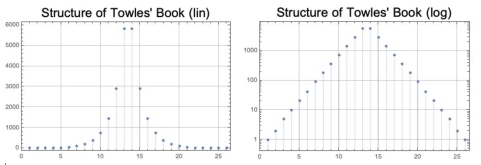
Bloomsday approaches, so let us re-Joyce once more. In Ulysses, Joyce makes numerous allusions to mathematical matters. On previous Bloomsdays, ThatsMaths has written about non-Euclidean geometry, Bloom’s efforts to square the circle, a possible encounter between Joyce and the famed logician Ernst Zermelo and the fractal complexity of Finnegans Wake [TM246 or search for “thatsmaths” at irishtimes.com].
Ulysses
There is no real maths in Ulysses but, in the Ithaca episode, Leopold Bloom and Stephen Dedalus touch repeatedly on weighty scientific matters. Reference is made to irrational numbers, infinite series, continued fractions and limits. Writing to Harriet Shaw Weaver, Joyce said that the Ithaca episode should be read by someone who is “a physicist, mathematician and astronomer and a number of other things”. He described this mathematical catechism in Joycean style as “a mathematico-astronomico-physico-mechanico-geometrico-chemico sublimation”, an overture to the “amplitudinously curvilinear” climax of Penelope.
Once Upon A Prime
 Joyce was not alone: many authors use mathematical metaphors with great effect. A recent book, “Once Upon A Prime” by Sarah Hart, describes the wondrous connections between mathematics and literature. Hart is Professor of Mathematics at Birkbeck College in London and holds the Gresham Professorship of Geometry, the oldest mathematics chair in the UK. She is the thirty-third person and the first woman to hold the Gresham chair.
Joyce was not alone: many authors use mathematical metaphors with great effect. A recent book, “Once Upon A Prime” by Sarah Hart, describes the wondrous connections between mathematics and literature. Hart is Professor of Mathematics at Birkbeck College in London and holds the Gresham Professorship of Geometry, the oldest mathematics chair in the UK. She is the thirty-third person and the first woman to hold the Gresham chair.
 Hart writes about the mathematical patterns in poetry and the arithmetic of narrative choice. She examines the structure of many novels, old and new. One intriguing example is the remarkable expansion and contraction of time found in a recent blockbuster, A Gentleman in Moscow, by Amor Towles, which is currently being filmed.
Hart writes about the mathematical patterns in poetry and the arithmetic of narrative choice. She examines the structure of many novels, old and new. One intriguing example is the remarkable expansion and contraction of time found in a recent blockbuster, A Gentleman in Moscow, by Amor Towles, which is currently being filmed.
For the first half of the novel, the timescale doubles from chapter to chapter, growing from one day to sixteen years. Over the second half, the scale reduces from sixteen years down to a single day for the final episode [see graphs at top of this post]. Towles notes that this structure suits the story well, with a granular description of the early days, less fine detail over the central period and “a reversion to urgent granularity as we approach the denouement.”
George Eliot had a considerable knowledge of maths and was acquainted with several leading scientists and mathematicians. She studied conic sections up to the end of her life; the names of these curves also describe literary styles: elliptical, parabolic and hyperbolic. Hart observes that, during periods of sadness or stress, Eliot would go for walks, play the piano or “just take a dose of mathematics every day”.

The Cycloid
In Moby-Dick, Herman Melville employed many mathematical metaphors, and he used the properties of a mathematical curve called the cycloid — the curve traced by a point on the rim of a rolling wheel — to explain Ishmael’s observation of the motions of a soapstone in a large cauldron. Ishmael observed that, wherever he placed the soap, it slid to the bottom in precisely the same time. This property, called tautochrony, was used by the Dutch scientist Christiaan Huygens to construct an accurate pendulum clock [see earlier post here].
Mathematical symbols can be visually appealing, just like a musical score or an astrological chart. But the inclusion of mathematical equations in a book often has the effect of scaring prospective readers. Stephen Hawking expressed a rule that each equation halves the sales. This is grossly in error although, generally, mathematical symbols are avoided; Tolstoy devised a mathematical equation to model military encounters, which appears in textual form in his magnum opus but, if you want to find out more, you must consult Hart’s delightful book — or else read War and Peace.
Sources
- Sarah Hart, 2003: Once Upon A Prime. Mudlark, x+290pp. ISBN: 978-0-0086-0108-9.
